Stockpiling food is a necessity for a variety of reasons and some that we have recently witnessed such as the COVID pandemic, natural disasters and shortage of infant formula in the US.
Disasters can happen at any time, so being prepared is important for you and your family’s survival. Disasters can come in many different forms from storms, floods, tornadoes to earthquakes. They can also be caused by diseases such as COVID. They may even be extreme such as societal breakdowns.
During any of these SHTF events, it may be difficult to get out and buy food, or food may be in short supply. You only have to think about what happened during the pandemic lockdowns and the empty supermarket shelves.
Also power outages caused by storms will render your refrigeration useless, so it is vital to have an emergency stockpile of food to fall back on during these times. Stockpiling food is a smart way to anticipate these events.
The Importance Of Appropriate Storage For Different Types Of Food
Ensuring appropriate storage for different types of food is important so as to protect it from losing its quality, nutritional value, and in some cases, being lost altogether.
As you will be relying on this food for survival, you need to make sure it will still be usable when you need it most. To keep food in the best condition, you need to consider different storage options for different types of food.
Keeping canned, dried foods, fruit and vegetables all in the same place is not a good idea. There are some other food storage myths that need to be debunked to make sure you keep your stockpile in the best conditions.
You Can Store Food Anywhere
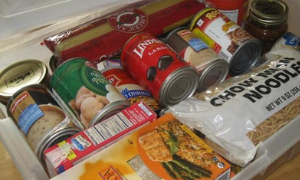 Some people advocate storing stockpiled food under beds, in closets, spare rooms, attics, garages, basements or anywhere there is space.
Some people advocate storing stockpiled food under beds, in closets, spare rooms, attics, garages, basements or anywhere there is space.
These approaches need to take into consideration three important factors, temperature, light and humidity.
The best places to store foods to keep them in tip-top condition are in cool, dark and dry places. The places mentioned above may not give you these ideal conditions.
Canned and dried foods will soon perish if you keep them in warm, damp places. Fruits and vegetables will not keep very well in places where there is too much light, heat or humidity.
Related: 7 Mistakes You Are Making When Buying Canned Foods
It’s possible that some of the places in your house may be too warm to store food, or too humid if storing food near a laundry room. It’s also possible that your garage or basement may be damp.
Waterproof paint can be used to help combat this problem. Even better would be to invest in a dehumidifier and put wooden pallets on the floor to raise food off the floor.
It may be that your basement or garage gets too warm. In this scenario, the concrete floors will probably hold in too much heat which is not your friend when dealing with long term food storage.
Put Everything In The Pantry
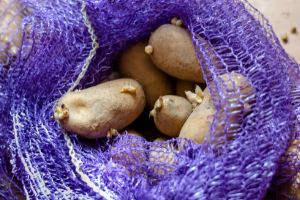 Some items are not suitable to be stored in the pantry such as fruit and vegetables because they need dark, cool places with plenty of ventilation to stay fresher for longer.
Some items are not suitable to be stored in the pantry such as fruit and vegetables because they need dark, cool places with plenty of ventilation to stay fresher for longer.
The absence of light is very important to stop vegetables like potatoes, onions and garlic from sprouting.
Other items that are suitable for a dry, cool pantry also need to be stored on separate shelves or areas within the pantry.
⇒ 126 Long Lasting Foods You Should Add To Your Pantry Before It’s Too Late
These items include canned foods, food in glass jars, dry foods, boxed foods, dry-vacuum foods, wet-vacuum foods, MREs and self-heating meals.
Food in glass jars should also be stored in a closed cardboard or other carton. This will prevent light damaging the contents.
All Food Types Can Be Stored The Same Way
Not all of your stockpiled food can be stored in the same way, nor in the same places. Some foods need to be unwrapped and kept in ventilated areas.
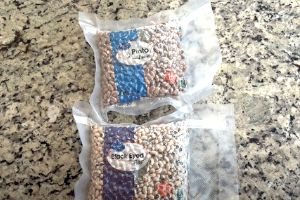
Others actually require airtight sealing to prevent damage.
Dry foods such as flour, rice, pasta, sugar, beans, spices, and dried fruits need to be vacuumed sealed or put in airtight containers not only to stop moisture ruining them, but also to stop strong odors affecting them.
Fruits and vegetables on the other hand should not be put in airtight containers. They should left to breathe in a cool, dry, dark ventilated space.
Put Everything In The Fridge
Fridges are one way of keeping some things fresher for longer. But not all food items take well to being put in a fridge.
Putting bread, cakes or donuts in a fridge will actually make them go stale faster than if they were in the pantry.
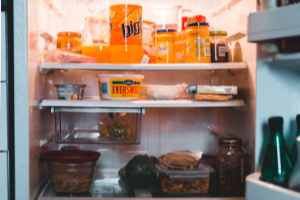
Tomatoes are best left out because they will go mushy in the fridge and also lose their flavor.
Potatoes, onions and garlic should not be kept in a fridge.
When potatoes get cold, the sugar that forms in them can be carcinogenic.
On the other hand, relying solely on electricity is never a good idea.
Related: Living without a Refrigerator – It Can Be Done!
One day, this might not be an option anymore. So it’s best to always be prepared for that and have alternatives, rather than be taken by surprise.
Store Fruits And Vegetable Together
Fruits and vegetables need similar storage conditions. However, it is not wise to store some of them too close together because of the ethylene gas that is given off by some. Ethylene gas will accelerate ripening and spoilage, so the area needs to be well-ventilated to avoid this.
The ethylene gas producers are bananas, melons, tomatoes, apples and pears. Fruit and vegetables like oranges, cucumbers, potatoes, squash and pumpkins are very sensitive to the gas. They need to be kept away so they don’t spoil quickly.
You’ve spent a lot of time, effort and money stockpiling your food. So you need to make sure it doesn’t go to waste, especially in times of need.
Most foods will keep for a very long time, but only if kept in the right conditions. How, where and with what you store your food items is crucial to determine whether they will last as long as you need them to.

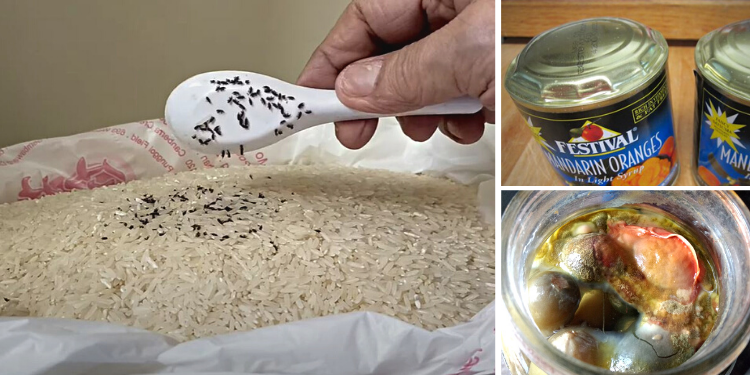













something glorifying WRONG going thru the article >> don’t be contaminating your canned goods by coating them with any “waterproof paint” – you can dip them in food grade wax (peelable cheese wax is best) – food grade mineral oil – any veggie oil including the pan no-stick spray >>> NO CHEMICALS
I case my bulk canned goods on corrugated flats – lid opening down – labels facing out for eazty ID – run some transparent adhesive tape around the bundle to unitize it – then stretch wrap the whole thing >>> you got a decade long package under most decent storage conditions ….
I just read again the statement in the article and I think what the author was actually saying is that waterproof paint can be used to paint the garage or the basement, not the food cans..
Jack, I wish there was waterproof paint that would actually work in a basement.
Water is probably the irresistible force unless you give it a easier route around your basement with drainage.
Cool, dark and dry PLUS rotation of first in and first out, eat your storage foods is too simple to call an article. But they work.
veg oil is extremely bad for
As a career (sic) water-proofer … elastomerics are the only thing that will waterproof any space and, even then, only when applied from the positive (pressure-applied) side (outside) of the hydrostatically enduced moisture source. Humidity cannot be water-proofed. Humidity must be removed/reduced/filtered from the air/enclosed environment mechanically or by chemical or mineral (desiccant) means. Plastic and rubber may be dipped to decrease their porousness … in wax or food grade elastormerics. Mylar also works on manageable sized packages when properly sealed but, of course, not on room-sized spaces although there isnan arguement that exterior walls made of cementicious materials and coated in mastics works … think backer board and quick set for instance, although it degrades over time. The bottom line is that you may store certain grains and dried beans in plastic bottles (for instance) provided they are wrapped and/or coated in an elastomeric or mastic. They’ll still last for years in straight plastic but their shelf life is doubled or tripled by coating. Enamel paint also helps to seal modern plastic bottles with little to no fear of any leaching taking place because the molecule involved with the curing process involved with enamels evaporates away from the bottle itself and is not sucked inwards over time even if the container is vacuum packed. The sealing molecule is too large to penetrate the plastic. Brittleness comes into play, over time, compared to elastomerics.
I turn my cans upside-down and mark them with the “Best By” month/year in large numbers so they are easy to see in dim light, like July 2024 would be 7/24, and store them upside down on heavy duty shelving in a spare room with the shades kept closed and the light off where they stay in a dark and relatively moderate temperature range. I also store my potatoes, onions, and squash in paper lined cardboard boxes in this spare room, so they stay dark, dry, and within a moderate temperature range. They would store better for longer if I had a colder storage area other than the refrigerator, but I have to work with what’s available, and digging a root cellar is not practical for me.
Paint for the basement walls , but I think you knew that.
Very good article.
I believe that the importance’s of correct food storage is more important then, water or shelter.
Think about it, you can always find shelter somewhere. you can most always find water, if you look hard enough. BUT food on the other hand, will be very, very, hard to find when most of the SHTF, has gone down. So, we need to take very good care of the stuff that we have put up for this time that is upon us, @ this time NOW…
Do your homework and read all the info you can to bring a better and more quality product, that you have put up in storage.
Your food will only take care of you as good as you take care of it.
I, battle with storage temps a lot. Trying to maintain a certain temp is very hard to keep, it’s runs up and then down. In the winter it’s too cold and then in the summer it’s too hot.
Yes, there’s a lot at stake, when you are talking about how much food you get to eat and how much food you throw away.
Just do the best you can, and you will get thru it, but you need to read up on everything you can, so you can use your knowledge to help those that, well the one’s that did not prepare.
“Waste not, want not” is an idiom that has a specific meaning, but it is neither of the two meanings you suggested. What it does mean, basically, is that if you do not waste that which you have (waste not), you will not later want that which you have wasted (want not).
The driest and most climate controlled room is a spare bedroom in your house, or at least in my house. Our spare bedroom is a storage room with floor to ceiling shelves, and is always as well climate controlled as the rest of the house. Garages, attics and storage sheds are the worst places for climate control.
red ant, I agree about finding shelter but disagree about water – finding enough water you can filter and sanitize to make potable depends on your location. If the Grid shut down for an extended duration, it will be much easier for me to find edible food than uncontaminated water.
Red ant, You are right to point out how important it is to read up on the subject. If the same advice is posted in only one space or by someone who’s page is half about something irrelevant like a TV show, move on. These are people who just like to see themselves on some media.
Something I have found with food storage is that it is useful, is to package the items in an easy to carry package, such a case of cans wrapped in cling wrap supported by packing tape. I have had to move my supplies a couple of times and found it helpful. I had a couple of 20 somethings move in and needed to clear out space for them. Having things in smaller easy to move packaging helped with being able to tuck things into smaller spaces.
Sagebrush Lin
Yes, I agree, if things are put into smaller sizes, then they will be easier to transport to other locations, with ease.
I to have had to move a lot of things when i sold a house i was using as a storage house. It was a pain but i did put 75% ins buckets for easer to carry and store. I can’t lift large things anymore, so I move a lot of smaller things. Work smarter not harder…
Good luck with the 20 somethings, that have invaded your space… lol
And yes, we just need to wipe our feet, from those TV show people.
Stay sharp. and thank you…
What makes potatoes carcinogenic?
Chip
When a potato gets cold, the sugars that forms in the potato can become carcinogenic.
Storage of potatoes should always be a ventilated place because they can give off a gas that will kill you.
The concentration of glycoalkaloid in rotting potatoes suffices to produce toxic effects in humans. Glycoalkaloids may cause headaches, diarrhea, cramps, and in severe cases coma and death;
Any idea why my potatoes I harvested from my garden, placed in an open cardboard box and put down in my cool and mostly dark (only light is from some LED LIGHTS in a few areas) have almost all turned green? Can’t eat them now.
Canning? Where does that come in? My wife cans all kinds of food in the proverbial Mason Jars and vacuum packs almost everything else. And even then, much of the vacuum-packed food are put in the chest freezer for protection and the canned goods in our downstairs dark storage area. And we do buy Foods 4Patriots often to build up our reserve. MREs are just there for emergency use
Foods for patriots are mostly made from GMO foods that have been SLATHERED in Round-up. I don’t want to get Hodgkin’s Disease nor any other cancers, thank you very much! We stick with putting up our own foods that we KNOW we can eat safely!
JESS, Certified Natural Health Professional since 2006
and MSEd.
If you can afford it, a home freeze dryer is great. I freeze dry bananas, apples, chili, meat, eggs, whole meals on and on. Properly packaged in airtight containers or mylar bags with oxygen absorbers food can last for dozens of years. Plus, freeze dried fruit make fantastic snacks to keep up energy and kids love them. You can even freeze dry candy and marshmallows!
Tracie: I have been saying the same thing on this site for awhile now. Right now, I am freeze-drying apricots that my orchardist friend sold to me for a measely $18/8 quart basket. In other words, he has NOT doubled the price of his fruits, like so many others have, THANK GOD!! We have also done blueberries, cole slaw mix, broccoli, mixed veggies, peas, chicken, ham, cottage cheese and brick cheeses, and I am going to try some scrambled eggs soon, too.
We also have a huge crop of gigantic blackberries just starting to come in, so I am going to freeze-dry some, and then make jam with some, plus we always let friends come pick when they are able, to lighten our load!
Those freeze-dried apricots are to DIE FOR! Oh my Goodness!!! So are the blueberries! Love, love, LOVE OUR Harvest Right Freeze Drier! We got it when they were on sale last August…It;s been worth every penny!! Now, on to the Plumcots and the Lamb Roast!
At 71, I remember canning all of every growing season because we relied on our canned food (meat as well as veg & fruit) to sustain our family all winter. Believe it or not youngsters, we didn’t have year-round shipping of fresh fruits, vegetables and meats in the very snowy parts of the US in the 50s and many times 60s & 70s. Planes & trucks just couldn’t get in and there were no super stores with their own hydroponic farms to provide during the winter.
I hope you all have some of your grandma’s recipes for USING your food storage and you are trying them out BEFORE you need them. Remember that if you don’t learn how to use your supplies, they can be really hard on your body. If you don’t normally eat soybeans and whole grains, for example, starting them all at once can be VERY hard on your digestion and make you quite ill. You have to train your body and palate to USE & ENJOY what you have – and rotate your supplies by USING them.
When you are living on canned/dried food, here’s a special grandma treat to nurture you when are craving fresh fruits that are not seasonally available:
Put a quart jar of fruit, or the dried equivalent – my favorites were boysenberries and peaches – in a saucepan with some water & sugar. Bring to a boil & cook dumplings on top. Heaven when served hot on a cold winter’s day!
Small amounts of meat and flour can go a lot further with dumplings. Can you make them? Can you successfully reconstitute your dried foods and cook a nutritious/tasty meal with them? Have you trained your palates to love them?
Have you tried eating a week ONLY off your food storage? Have you tried using some of the survival recipes in the Lost Ways? How did your body respond to eating cattails or making bread with cattail flour?
Your food storage is worthless if people won’t or can’t eat it. Experiment while you have abundance and train your body & palate to enjoy what you have stored. Best way to rotate.
What is the best vacuum sealer?
My son has processed a bunch of quality ground beef through the freeze drier without any additives other than a little salt and pepper. This way people with food sensitivities can eat without any problems. Almost all of the commercially freeze dried foods have products in them that some of us might never eat so Kati J’s comment below regarding storing foods that will actually settle well and not cause digestive problems is valid.
Blackberries are tough to get thoroughly dry. Ours never did. We probably won’t do those again. Our favorites are blueberries (although every one must be pierced), strawberries, pineapple and raspberries.
woweewow! over $2500 for a small one? just entered the contest to win one lol
They are pricey. I bought one for my son and his family back when my income was much higher. His family has a couple of people with food sensitivities so commercially packaged freeze dried foods would be very unhealthy.
If you do happen to win the prize, note that it will also need a compressor and the oil to run it plus a space where you can run a loud and noisy machine.
Every dang thing doesn’t need to be vacuum sealed. That is utterly ridiculous. Be aware of YOUR weather and storage requirements. If you don’t have a dry area to store your food, you *may* need to vacuum seal your food, though it would probably just be cheaper to buy a dehumidifier, vs rolls of overpriced vacuum rolls. (I live in the south and we put an a/c in the garage almost as soon as we moved in to keep the humidity down… didn’t want our tools rusting. It’s been a boon for food storage, too.
I keep my canned food and home canned in a dark cool basement. Humidity is similar to the rest of the house. Never have any issues with tools rusting or anything else in there. I store dry goods in food safe 5 gal buckets purged with co2 using dry ice before I seal them up. Look for YouTube video by RedRose to see how to do that
Just heard the idea of ac in my garage. Think I’ll look into that. I’m so lusting for a root cellar, but permits, telling the world in not my thing.
Depending on where you live, call it a storm shelter… Place to hide from Tornados, Hurricane force high winds, etc…..
Reply to Nan.
We have and use a MealSaver and a SealAMeal. Both work fine.
Why turn canned goods upside down??
LouTBS, Some advise turning the cans over every 6 months so that the food doesn’t settle and separate. I am not that organized so I don’t know by experience. One thing I do make sure of is to not use flip top cans for long term storage. The metal is not very sturdy at the perforation point. I instead keep a couple of manual can openers stored in a couple of places for the cans with traditional lids.